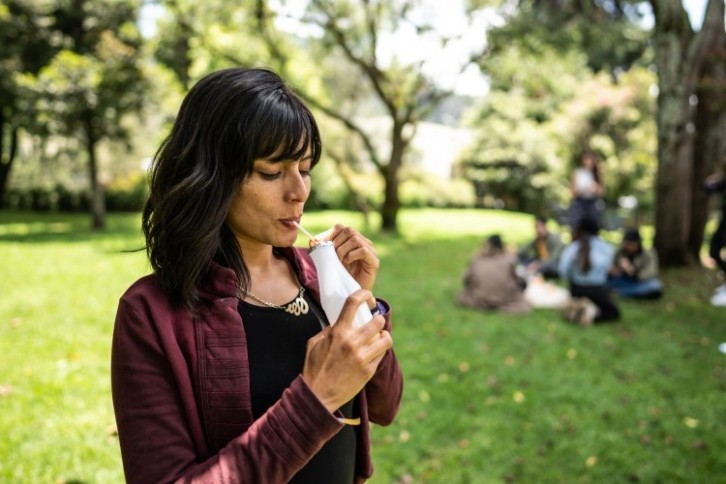Dairy trends unwrapped: Consumers seek added value, scrutinize claims

Global consumer research carried out by GlobalData for ingredient supplier IFF has shed light on the latest market and sensorial trends in dairy, with additional functional and environmental benefits and verifiable label claims being a key driver in purchasing decisions.
GlobalData surveyed 21,000 respondents from 42 countries across Western and Eastern Europe, North America, Central and South America, Asia-Pacific, the Middle East and Africa to identify overarching trends, such as health and wellness, affordability and added value, as well as drivers in product categories such as beverages, desserts, ice cream and plant-based.
One key takeaway is that food inflation has failed to drive consumers away from dairy, with most global shoppers indicating they would rather pay a higher price than settle for average-quality products.
“Dairy has been one of the categories worst hit by inflation, with value CAGR outstripping volume CAGR, and this has been more pronounced in subcategories such as milk, butter and spreadable fats,” Richard Neish, head of global futures, consumer intelligence, at IFF, told us. “It must be said that the majority of global consumers are currently unwilling to sacrifice quality in the face of high prices, with 52% preferring to pay more for dairy to ensure quality is not compromised, and 63% starting to buy, continuing to buy, or more frequently buying expensive or luxury dairy brands in Q4 2023.”
Seeking ‘value with values’ in private label
Despite this, there’s no escaping the fact that 35% of the consumers surveyed did switch to private label products in a bid to trim their dairy spend, he added. “As a result, sales of private label products have increased significantly, particularly in Europe, as they are perceived as offering greater affordability and similar quality to branded dairy,” he explained. “This may be due to consumers believing that brands are profiteering by using macroeconomic pressures as an excuse to disproportionately raise prices – also known as ‘greedflation’.”
“Today’s savvy shoppers are increasingly seeking products that offer “value with values” – affordability coupled with quality, safety, ethics, sustainability, and a yearning for simplicity in what feels like an increasingly chaotic world.”
Brands can appeal to budget-conscious consumers by balancing their needs against their values. “This can be achieved by building in additional value such as health, ethical or sustainability benefits, such as by adding probiotics, or by using higher-welfare or locally sourced milk,” Neish explained.

“Furthermore, time-poor consumers put a premium on products that can help them live their everyday lives more efficiently and effectively. For those who prize healthy convenience, versatile products that can be consumed on the go as ‘top-up’ nutrition will appeal.”
Demand is also growing for snack-sized dairy products that offer greater nutritional value, including low-fat cheeses, gut-healthy yogurts and functional dairy drinks, the research shows. Popular trends identified in the survey include low-fat cheese, gut-friendly yogurts and functional dairy beverages.
Ambient dairy innovation is also one to watch, according to the research, with IFF stating that there’s an opportunity for shelf-stable products with added health benefits, such as probiotics.
Putting a positive spin on ‘shrinkflation’
Besides adding value through formulation, brands can attract shoppers to premium ranges by adjusting pack sizes. But with consumers weary of ‘shrinkflation’ – the practice of shrinking the pack size while keeping the product’s price the same or higher - this strategy has to be carefully executed, said Neish. The good news is, there is appetite for smaller packs that balance value with quality.
“Consumer research shows that in 2023, younger cohorts – and Generation Z in particular – were more inclined to choose smaller dairy pack sizes,” Neish told us.
"Busy, often single lifestyles are associated with smaller, convenience-led serving sizes that minimize the risk of waste. At the same time, the typically tighter budgets of younger consumers may deter them from purchasing larger, high-priced packs. This offers a real opportunity for dairy brands to target younger consumers with convenient, smaller-sized products."
“However, if brands choose to boost affordability by shrinking pack sizes, they must clearly communicate this positive value spin to consumers, or otherwise risk being accused of ‘skimpflation’ tactics.”
From indulgence to healthy living and experimentation
With 50% of global consumers willing to reward themselves with pleasurable experiences and through food more than they did pre-pandemic, there’s an opportunity in balancing indulgence with health and wellness. Sugar reduction plays a key part here, as Neish explained. “The most influential megatrend across the food and beverage space since the pandemic has been health and wellness, and it will continue to dominate the dairy sector in 2024,” he said.
“Sugar reduction plays a part in this, with consumers increasingly scrutinizing sugar content and displaying an appetite for lower-sugar products. Research shows that 72% of consumers are trying to reduce or eliminate sugar from their diets, while 32% define healthy foods as being low in sugar.”
And yet, in popular categories such as dairy desserts and ice cream, it’s all about indulgence. “Dairy desserts are very much about indulgence, with consumers demonstrating a strong desire for sensory innovation while also enjoying traditional, nostalgia-inducing products,” Neish said. “This gives brands an opportunity to explore and innovate with classic and novel flavors, and to create exciting textural/multi-textural experiences to engage consumers. Limited editions and co-branding also have appeal and allow brands to push boundaries.”
For most consumers, ice cream is an indulgent comfort food where taste remains king, he added. Traditional flavors are favorite for all consumer demographics, the research showed, but when it comes to unusual and new, trendy flavors, these are most often the pick of younger cohots, particularly Gen Z and Millennials.
“While most customers still prefer traditional dairy flavors, Generation Z and Millennials are particularly keen to experience new and unusual options, with their choices more influenced by social media than older cohorts,” Neish said. “Within this category, balancing indulgence, innovation and value for money is key.”
While social media platforms like TikTok are effective in allowing dairy brands to demonstrate the use of simple ingredients in novel and exciting ways, it’s home cooking which remains the number one vehicle for experimentation, the research suggested. When asked what situations inspire them to try new flavors in food, an average of 52% among Gen Z, Gen Z, Boomers and Millennials said ‘cooking at home’. This was followed by ‘visiting a different country’ (40%) and ‘purchasing from a retail outlet’ (36%).
Gaining trust through transparent label claims
With responsible consumption a major driver for purchasing decisions, the research identified that some consumers doubt brands’ honesty when it comes to their sustainability credentials. According to the survey, while 64% of global shoppers thought that information shared by brands is ‘generally reliable’, 69% ‘somewhat’ or ‘strongly’ agreed that big brands claim to be more eco-friendly than they actually are.
Almost one in three shoppers (32%) thought that small or independent brands were the most trustworthy when it came to their ethical, social and environmental claims, compared to 15% backing private label and 24% - multi-nationals.
Dairy alternatives are also suffering a crisis of consumer trust, with shoppers doubting the positive impact of switching away from dairy.
“While dairy has recently faced scrutiny as media coverage has brought criticism of animal agriculture into the mainstream, consumers are also catching up with the reality that not all dairy alternatives are as “green” as they initially seemed,” Neish explained. “Instead, they are reassessing the validity of health and sustainability claims around, for example, plant-based milk, which is now seeing a significant slowdown in market growth.”
“For both dairy and alt-dairy manufacturers, it’s vital to be transparent and accurate about their environmental impacts, ethical credentials and sustainability commitments, especially in the face of an increasingly strict regulatory environment that is putting claims under greater scrutiny than ever before.”
So, what should brands be doing?
In an age of artificial intelligence (AI) and ever-evolving social and consumer trends, building an emotional connection with the consumer can boost loyalty and repeat purchases, the study suggests. “Dairy brands can engage with consumers to drive “value with values” through story-telling – highlighting authentic environmental, ethical and social credentials that reflect consumers’ concerns and values,” Neish told us.
“As an everyday essential, dairy has not always prioritized such personal engagement with the consumer, but this is changing.”
“Generation Z’s growing influence means dairy companies are realizing the need to build marketing strategies that tell more complex, meaningful stories around trends that matter to a large young audience, including sustainability, authenticity and technical innovation. Key areas for dairy and dairy alternatives to champion include local and ethical sourcing, regenerative farming practices and the use of renewables.”




